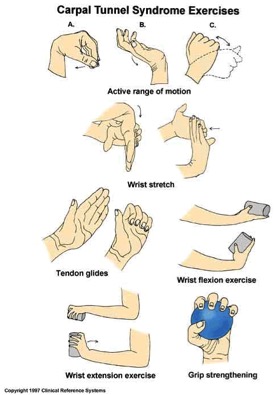Carpal Tunnel Syndrome

Are you feeling numbness, tingling, weakness and/or pain in your hand, wrist or forearm? If your answer is yes, you may be experiencing carpal tunnel syndrome; a common condition caused by pressure on the median nerve which runs through the wrist.
The carpal tunnel is a narrow passage, surrounded by the bones of the wrist and the transverse carpal ligament. The median nerve is what runs through the carpal tunnel and provides the thumb, forefinger, middle finger and half of the ring finger with feeling. Nine other tendons, known as flexor tendons, also pass through the carpal tunnel and flex the fingers and thumb. If this passage becomes narrowed or swollen, pressure is placed upon the median nerve and blood supply is reduced.
There are various reasons that carpal tunnel may develop. Research shows that women are three times more likely to develop carpal tunnel syndrome than men as they naturally have a smaller carpal tunnel, and the risk grows even greater during pregnancy. Hormones that are produced during pregnancy can cause fluid retention and swelling which therefore leads to pressure on the nerve. Repetition of the same movement or activity can also lead to carpal tunnel syndrome. For example, typing, gardening and assembly line work are repetitive activities that can cause the tendons in the carpal tunnel to become inflamed and irritated. Other risk factors include diabetes, excessive weight, high blood pressure, arthritis, wrist injury and certain medications.
The management of carpal tunnel syndrome can differ depending on the severity of the condition. Nerve stretches are an effective, useful method to relieve some of the symptoms that carpal tunnel syndrome causes. These stretches include the prayer stretch, wrist flexor stretch and wrist extensor stretch, among others. These nerve stretches are a simple activity that if done consistently, can lessen the pain and discomfort from carpal tunnel syndrome. Wearing a splint or brace, especially at night helps to keep the wrist in a neutral position, reducing pressure on the nerve in the carpal tunnel. Physiotherapy is another way to reduce pain and help to regain strength and mobility in the hand and wrist area, as well as to learn more about beneficial exercises, such as the nerve stretches, that can be done at home. Over 80% of those who suffer from carpal tunnel syndrome normally have a positive response to non-surgical treatments. However sometimes these treatments are not effective or symptoms reoccur, and therefore a carpal tunnel release procedure may be considered in these cases.
Altaira’s Lead Physiotherapist, Michael, holds both a Bachelor of Physiotherapy and a Bachelor of Medical Science degrees, and has an extensive background in Occupational Health. He is an Australian Physiotherapy Association member and believes in the provision of evidence based practice and holistic client-centred care. He is extremely passionate about assisting clients to maintain their independence and empowering them to self-manage their musculoskeletal health in a way that is relevant and meaningful for them. Book in a consult with Michael via: Make a Booking (nookal.com) Learn more about Altaira’s Allied Health services: Allied Health – Altaira Services

Example of effective nerve stretches



